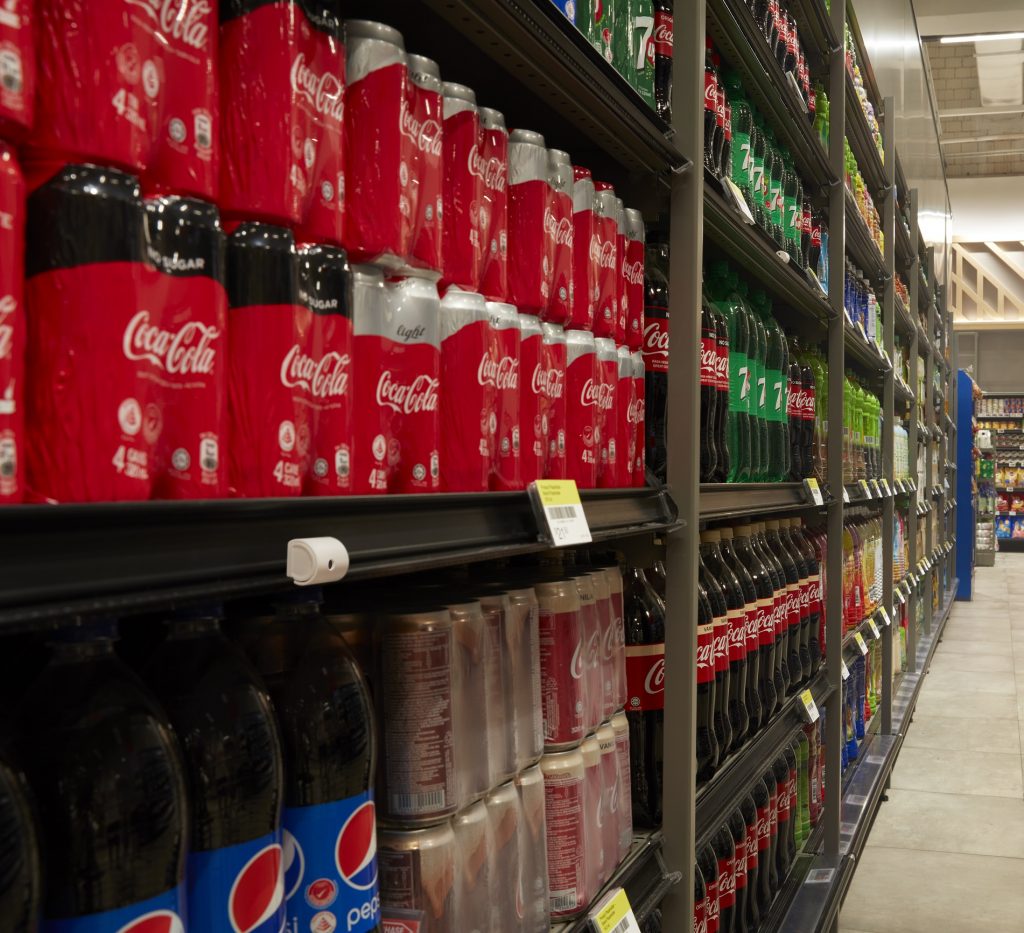How to build a perfect store in retail: 5 steps to drive sales growth

Shoppers either walk into a store with the intention of buying something specific, or just stroll around to pass the time and maybe find something they suddenly desire – whether it’s food, games, furniture, etc. If they end up purchasing their favorite bar of chocolate, for example, they walk out with a smile on their face.
If you are a retailer or an FMCG company, you know that it has very little to do with fate. Rather, it is the result of meticulous and complex analyses of consumer insights, shopper behaviors, shelf merchandising, and retail sales data, which enabled you to create the perfect in-store conditions for that type of shopper to find and buy this chocolate.
Manufacturers play a crucial role in making the proper suggestions to retailers to achieve the perfect store arrangements. How do they manage to figure out the best shopper experiences for their brands and translate them into feasible win-win recommendations to their clients? By designing and implementing effective perfect store strategies.
What is a perfect store?
The ultimate goal of a perfect store is to create an enhanced shopping experience that:
- Helps shoppers find what they were looking for right away
- Triggers impulse purchases where shoppers leave the store with something they had not necessarily planned to buy.
How do CPG manufacturers manage to build the best perfect store strategy for retailers? By turning the shopper insights that they collect into clear in-store execution guidelines to implement at the shelf level.
When putting together the strategy behind those guidelines, they may consider the following:
The 6 ‘P’s of marketing: product, price, pack, promotion, place, and proposition can be used as strategic anchors to build the perfect in-store conditions to the right channels and markets.
Shelf visibility: ensuring proper visibility on the shelf is a must. A product that a shopper cannot see cannot be purchased. It leads shoppers to purchase a competitor’s product, or give up on the entire category, thereby impacting sellout.
Actionable and measurable channel plans: being able to easily implement the right planograms in the right locations is essential for manufacturers to maximize their opportunity to become retailers’ preferred partners and drive sales growth. So is measuring their perfect stores’ impact on business activities to optimize their strategy and reach sales targets.
Getting those elements right necessitates the full attention of several departments. In most cases, the trade/customer marketing and sales operations teams oversee the design and implementation of the most efficient perfect store strategy.
How do you build the best perfect store strategy?

Step 1: Know your shoppers from the inside-out
A purchasing act is rarely based on a mindless decision. FMCG companies and retailers invest a substantial amount of time and money in getting to understand shoppers and influence their decisions throughout the path to purchase - the journey that leads a shopper to buy a specific product. What triggered that decision? Why did they decide to buy one brand of chocolate rather than another? How did they end up purchasing chocolate when they originally walked into the store looking for pasta?
An in-depth understanding of the path to purchase allows marketers to make the greatest impact on each decision in favor of the brands they support. Even more, it helps them identify their most valuable shopper targets and the most effective ways to reach out to them.
Quantitative and qualitative research leveraging a variety of data sources, from shelf or e-POS data to data drawn from shopper panels and third parties, will provide FMCG brands with powerful insights into shopper behaviors inside the store, their traffic flow, basket size and composition, adjacencies, as well as why and how they are attracted to specific products in specific channels.
That will help CPGs design the best recommendations for their clients and implement the perfect store in strategic outlets. Most FMCG companies have access to this data; many collect in-store product performance metrics from third-party auditors, and nearly 90% get data directly from retailers, according to an IDC Manufacturing Insights report. But it is through the consistent collection of various data sources that manufacturers will develop a deep understanding of shoppers and recommend perfect in-store experiences for retailers to implement. Cross-referencing these data points will help them determine expected price points, product locations (in the store and on the shelf), how they should be displayed, and what type of communication they would like to receive.
Step 2: Use the g ‘P’s as strategic anchors
Why are some brands more successful than others? It takes an understanding of all the aspects of the retail value chain, but winners realize that ultimately, the shelf is the most important “battlefield”. Think of it like a funnel: from their extensive research, FMCG manufacturers know how to win shoppers’ hearts and minds and can therefore grasp the rules of their product category. Thanks to that knowledge, they can easily identify their sales drivers and design their picture of success — their ideal shelf — to optimize in-store performance. Some major industry players do so by drawing upon their analyses to slightly adapt the 6 ‘P’s of marketing according to shoppers’ needs and behaviors in-stores to increase sellout. Here’s how.
Product: The assortment of products offered must be adequate, but FMCGs must also consider performance in comparison to their competition to measure how well products are doing in-store and how appealing they are to their target audience. Selecting the right product for the right channel is also important; not every retailer sees the same types of shoppers coming through their front door. Knowing which persona visits which type of store is essential for CPG brands to select the right products to display on the shelves in order to optimize consumer satisfaction and increase basket size.
Place: Consumers are used to seeing certain items placed in specific locations in-store in some markets. So they usually know where to find their favorite deodorant or cherry-flavored yogurt. These areas in the store are called ‘destination zones’.
But FMCG companies may also want to create opportunities for shoppers to add some unplanned items to their basket or discover new entrants – for example, the same deodorant, but for sensitive skin instead of the regular variant. These areas in the store are called ‘impulse zones’.
In-store placement is key for visualization and purchase consideration. Floor plan, aisle placement, primary shelves, or secondary placements such as gondolas or specific displays are all meticulously taken into consideration by retailers and CPGs to ensure that all products effectively attract the right consumers. Answers to questions such as “Should this new laundry detergent be displayed at the store entrance in addition to its usual section?”, or “Should it be displayed in the aisle dedicated to items on promotion –with a discount coupon?” must be fact-based and pre-determined to enhance the shopping experience and maximize sales.
The same goes for shelf placement. Knowing whether a product should be placed at eye-level or not, next to a specific segment, close to competing products, or next to new assortments and why, are all aspects that manufacturers should be able to explain to retailers in their merchandising recommendation. Addressing these questions is also part of the rationale behind the best perfect store strategies. That means category teams should have in mind both the broad picture of the product performance and a more segmented one specific to stores and locations. This is how FMCG firms will successfully attract and convert the right shoppers.
Price: Since it all comes down to how much a shopper is willing to pay for a specific product, pricing dynamics are essential to achieve and implement the perfect store. On top of that, certain products are also subject to pricing restrictions in some markets, and some retailers may not be willing to go above a certain price for a product.
So, what makes one product worth more than another? How sensitive is the shopper to price? Is the brand gaining or losing share at the current price level? Is the brand profitable versus internal objectives and external benchmarks?
Choosing the right price to meet CPGs’ overall company objectives is a difficult task, but it enables them to handle the value perceptions of their brand to attract and win more shoppers while maximizing sales margins. There are multiple research methodologies that quantify the impact of price changes on volume and revenue. A perfect store strategy is one that leverages the depth of the portfolio to offer multiple price points that are catering to all key shopper targets.
Packaging: Even the greatest products in the world won’t sell if their packaging is not optimized to help shoppers navigate the shelf easily. In a perfect store, leading FMCG companies select packaging according to shoppers’ purchase intentions and agree on the right size of SKUs by considering specific retail environments and channels. The package design should be clearly visible on the shelf and use color combinations and fonts that make products stand out from the rest.
Promotion: How can a promotion incrementally accelerate sales? Any discount, value added promotion, coupon, special offer (such as 50% on second identical product purchased) can strongly support sellout, if well targeted. Effective promotions can encourage new users to try a product for the first time, reward existing users, increase pantry stocking or trigger impulse purchases, boosting sales for a whole category. The ones that drive total category growth are usually the ones retailers prefer.
Proposition: A new product that does not come up with a strong proposition might just end up confusing shoppers. As they build perfect stores, FMCG companies must communicate the value of their products to shoppers as effectively as possible. Ensuring a strong proposition by appealing to shoppers’ emotions or by educating them on the intrinsic benefits of a product can make the difference between a top and a delisted SKU. Manufacturers must make sure that their proposition efforts focus on star SKUs, as they will help build a stronger relationship with shoppers and increase consumer loyalty toward their brands. That should directly impact the way shoppers interact with CPGs’ products at the point of sale. That is why FMCG companies that win at the shelf include proposition in their overall POS execution guidelines and adapt it to certain categories or channels. A key driver in a successful perfect store strategy is to direct the communication in-store toward the shopper and not the consumer, if they happen to be different (a product for kids’ consumption might be purchased in-store by the mother).
Step 3: Have a clear picture of success to implement a perfect store
In most cases, FMCG companies determine their picture of success by laying out a set of best practices and rules per retail channel, such as:
- Bestsellers or SKUs growing popular must be placed at arm or eye level.
- Similar products of the same brands must be regrouped into blocks to visually impact shoppers at the shelf.
- Product complementarity should be leveraged in high flow locations to build adjacencies and trigger impulse purchases to maximize sellout opportunities.
- Promotions should be visible on the shelves or on secondary displays only.
- Pack sizes should be bigger in discount stores to offer best value for money.
- Price should remain on target in all channels (with minor fluctuations in remote areas).
- Analytics combining ePOS data with product characteristics should be used to build on category growth opportunities and optimize sales.
Once CPG companies have a clear vision of their picture of success, they can share it with their teams to adapt and execute it in every strategic channel.
Step 4: Share the perfect store strategy and make it every collaborator’s business
This step is crucial to the success of every perfect store strategy. To properly implement their perfect store, FMCGs must share their vision in a clear, attractive way with easy-to-execute instructions for every department – namely, the merchandising, customer marketing, sales operations, and field sales teams.
Achieving the perfect store requires complete alignment to deliver the same picture of success; from translating the perfect store vision into format- or store-specific planograms to executing and monitoring in-store performance. That is why winning CPG manufacturers provide clear and detailed directions at every stage of the perfect store process, for every category, store, or channel type.
As a result, they can have close to 20 different guidelines according to the level of personalization and monitoring some perfect stores require. More and more, new roles emerge to coordinate this activity. Perfect store or retail execution excellence manager roles are on the rise in the retail sector as CPGs track the implementation of their picture of success and aim at closing any retail execution gaps.
Step 5: Align KPIs and reporting metrics
The perfect store enables FMCGs to reinforce their position with retailers, track in-store performance, and incentivize sales reps in a meaningful way by shifting their focus back on adding customer value rather than on sales volume. Thanks to their perfect store strategy, FMCG companies give field reps a concrete and measurable opportunity to manage and deliver best-in-class execution, as well as quickly identify and sort out any possible hiccups.
But this can only be truly valuable to CPGs if the measurement process is standardized and scalable across the entire organization. You cannot manage what you cannot measure consistently. For instance, if two markets have different ways of gauging their share of shelf, it might jeopardize central teams’ analysis. Therefore, it is essential to measure KPIs according to the same method in order to track and report the same metrics across the entire organization.
How do you execute and monitor your perfect store strategy?
When it comes to executing and monitoring a perfect store strategy, standardization and consistency are essential. Successful FMCG companies have a system in place to ensure a pristine execution and maximize opportunities in-store. New technologies have made this process much more practical and precise by allowing FMCGs to instantly track and digitally measure shelf implementation and compliance. Forward thinking companies now provide their field forces with advanced retail execution tools such as sales force automation or image recognition, for example.
By empowering sales reps with best-in-class technologies, manufacturers ensure that field forces are guided in every step of the perfect store execution process – before, during, and after each store visit. Instead of using Excel spreadsheets to produce scorecards that review and measure performance, field sales teams can directly track retail execution progress on mobile and web applications.
For example, the best image recognition solutions in the market give sales reps (and their managers) instant visibility over their stores’ planogram compliance level. They highlight the outlets reps must visit before the end of the period and help them optimize their visit schedule by locating the nearest stores in their area. In store, field reps only need to take pictures of shelves with their smartphone or tablet to perform their store check and receive detailed KPI reports comparing shelf reality with perfect store requirements. Such technologies, which provide over 95% accuracy — 15 to 40 percentage points above manual measurements’ accuracy level — enable reps to fix planogram compliance gaps within minutes and guarantee the continuity of the perfect store.
Keep on iterating in a perfect store world
As shoppers’ needs evolve and as new competitors enter the market, category, customer marketing, and sales operations teams must constantly refine their perfect store strategy based on in-store successes and failures. Bain & Company notes that this strategy can grow FMCG sales by 5% to 15% annually. Knowing what works in each channel helps the best companies stay ahead of the game and determine new products’ most efficient in-store activation before they are even launched.
“Product portfolio is based on space availability, merchandising plans on placement feasibility. Promotional plans and new SKU listings are tied to top customers’ commercial calendars, with above-the-line and below-the-line investments in sync. Not only does this help a company focus on what can succeed in a particular store, but it also has the benefit of streamlining the organization to what matters most.” (Bain & Company)
By instilling a perfect store mindset and supporting teams with appropriate tools and processes, CPG manufacturers can use the perfect store as a strategic weapon to win the retail war.
This article originally appeared on the blog site of Planorama, a Trax company.



